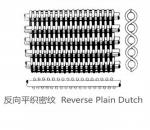Search Product
Search here for what you are looking for:
Search here for what you are looking for:
Stainless Steel is one of the most common material used to create woven wire mesh, because it is extremely chemical resistant, works with hot or cold liquids, and is easily cleaned. Common raw materials used to create woven wire mesh include 304, 304L, 316, 316L. Due to the characteristics of stainless steel wire, the wire mesh have favourable features, such as, sturdy construction, extremely commonly, easy to install and easily cut to fit.


There are five common patterns of Stainless Steel mesh weave . The first one is plain weave, is the most basic type of weave. In plain weave, the warp and weft are aligned so they form a simple criss-cross pattern. Each weft thread crossed the warp threads by going over one, then under the next, and so on. The next weft thread goes under the warp threads that its neighbor went over, and vice verse. The second one going to twill weave, in a twill weave, each weft or filling yarn floats across the warp yarns in a progression of interlaces to the right or left, forming a distinct diagonal line. This diagonal line is also known as a wale. A float is the portion of a yarn that crosses over two or more yarns from the opposite direction. The third one is talking about plain dutch weave, is similar with plain weave, just the weft and warp wire have different wire diameter and different mesh size. And the forth one twill dutch weave, similar with twill weave, just the weft and warp wire have different wire diameter and different mesh size. The fifth one reversed dutch weave, different from standard dutch weave lies in the thicker warp wires and less weft wires.